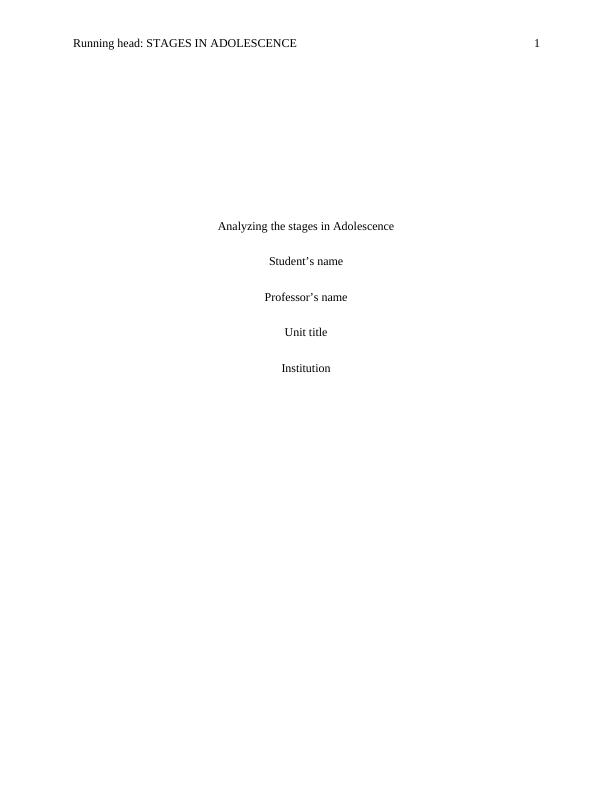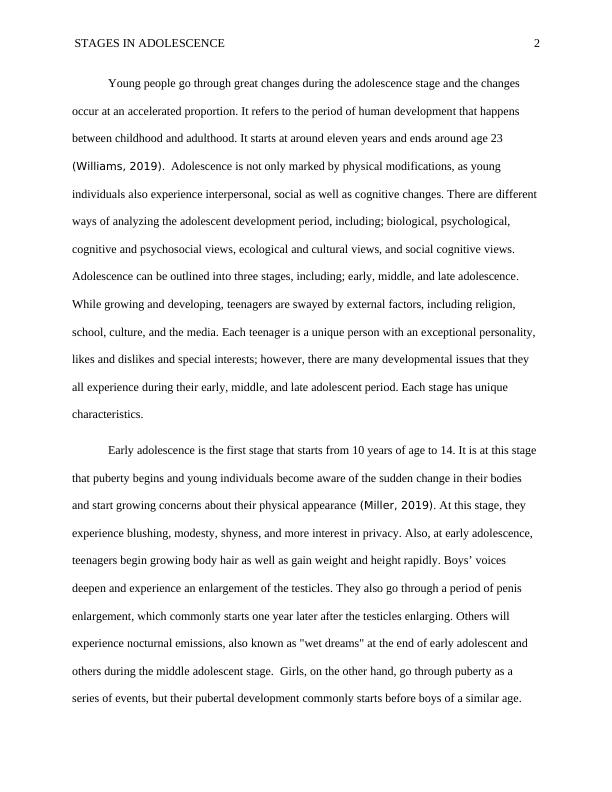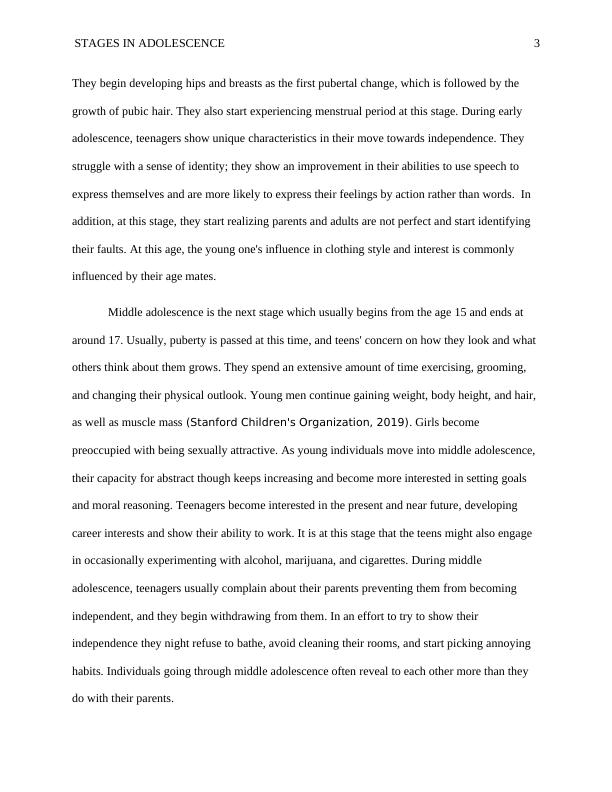Analyzing the stages in Adolescence
Added on 2022-11-25
6 Pages1295 Words399 Views
Running head: STAGES IN ADOLESCENCE 1
Analyzing the stages in Adolescence
Student’s name
Professor’s name
Unit title
Institution
Analyzing the stages in Adolescence
Student’s name
Professor’s name
Unit title
Institution

STAGES IN ADOLESCENCE 2
Young people go through great changes during the adolescence stage and the changes
occur at an accelerated proportion. It refers to the period of human development that happens
between childhood and adulthood. It starts at around eleven years and ends around age 23
(Williams, 2019). Adolescence is not only marked by physical modifications, as young
individuals also experience interpersonal, social as well as cognitive changes. There are different
ways of analyzing the adolescent development period, including; biological, psychological,
cognitive and psychosocial views, ecological and cultural views, and social cognitive views.
Adolescence can be outlined into three stages, including; early, middle, and late adolescence.
While growing and developing, teenagers are swayed by external factors, including religion,
school, culture, and the media. Each teenager is a unique person with an exceptional personality,
likes and dislikes and special interests; however, there are many developmental issues that they
all experience during their early, middle, and late adolescent period. Each stage has unique
characteristics.
Early adolescence is the first stage that starts from 10 years of age to 14. It is at this stage
that puberty begins and young individuals become aware of the sudden change in their bodies
and start growing concerns about their physical appearance (Miller, 2019). At this stage, they
experience blushing, modesty, shyness, and more interest in privacy. Also, at early adolescence,
teenagers begin growing body hair as well as gain weight and height rapidly. Boys’ voices
deepen and experience an enlargement of the testicles. They also go through a period of penis
enlargement, which commonly starts one year later after the testicles enlarging. Others will
experience nocturnal emissions, also known as "wet dreams" at the end of early adolescent and
others during the middle adolescent stage. Girls, on the other hand, go through puberty as a
series of events, but their pubertal development commonly starts before boys of a similar age.
Young people go through great changes during the adolescence stage and the changes
occur at an accelerated proportion. It refers to the period of human development that happens
between childhood and adulthood. It starts at around eleven years and ends around age 23
(Williams, 2019). Adolescence is not only marked by physical modifications, as young
individuals also experience interpersonal, social as well as cognitive changes. There are different
ways of analyzing the adolescent development period, including; biological, psychological,
cognitive and psychosocial views, ecological and cultural views, and social cognitive views.
Adolescence can be outlined into three stages, including; early, middle, and late adolescence.
While growing and developing, teenagers are swayed by external factors, including religion,
school, culture, and the media. Each teenager is a unique person with an exceptional personality,
likes and dislikes and special interests; however, there are many developmental issues that they
all experience during their early, middle, and late adolescent period. Each stage has unique
characteristics.
Early adolescence is the first stage that starts from 10 years of age to 14. It is at this stage
that puberty begins and young individuals become aware of the sudden change in their bodies
and start growing concerns about their physical appearance (Miller, 2019). At this stage, they
experience blushing, modesty, shyness, and more interest in privacy. Also, at early adolescence,
teenagers begin growing body hair as well as gain weight and height rapidly. Boys’ voices
deepen and experience an enlargement of the testicles. They also go through a period of penis
enlargement, which commonly starts one year later after the testicles enlarging. Others will
experience nocturnal emissions, also known as "wet dreams" at the end of early adolescent and
others during the middle adolescent stage. Girls, on the other hand, go through puberty as a
series of events, but their pubertal development commonly starts before boys of a similar age.

STAGES IN ADOLESCENCE 3
They begin developing hips and breasts as the first pubertal change, which is followed by the
growth of pubic hair. They also start experiencing menstrual period at this stage. During early
adolescence, teenagers show unique characteristics in their move towards independence. They
struggle with a sense of identity; they show an improvement in their abilities to use speech to
express themselves and are more likely to express their feelings by action rather than words. In
addition, at this stage, they start realizing parents and adults are not perfect and start identifying
their faults. At this age, the young one's influence in clothing style and interest is commonly
influenced by their age mates.
Middle adolescence is the next stage which usually begins from the age 15 and ends at
around 17. Usually, puberty is passed at this time, and teens' concern on how they look and what
others think about them grows. They spend an extensive amount of time exercising, grooming,
and changing their physical outlook. Young men continue gaining weight, body height, and hair,
as well as muscle mass (Stanford Children's Organization, 2019). Girls become
preoccupied with being sexually attractive. As young individuals move into middle adolescence,
their capacity for abstract though keeps increasing and become more interested in setting goals
and moral reasoning. Teenagers become interested in the present and near future, developing
career interests and show their ability to work. It is at this stage that the teens might also engage
in occasionally experimenting with alcohol, marijuana, and cigarettes. During middle
adolescence, teenagers usually complain about their parents preventing them from becoming
independent, and they begin withdrawing from them. In an effort to try to show their
independence they night refuse to bathe, avoid cleaning their rooms, and start picking annoying
habits. Individuals going through middle adolescence often reveal to each other more than they
do with their parents.
They begin developing hips and breasts as the first pubertal change, which is followed by the
growth of pubic hair. They also start experiencing menstrual period at this stage. During early
adolescence, teenagers show unique characteristics in their move towards independence. They
struggle with a sense of identity; they show an improvement in their abilities to use speech to
express themselves and are more likely to express their feelings by action rather than words. In
addition, at this stage, they start realizing parents and adults are not perfect and start identifying
their faults. At this age, the young one's influence in clothing style and interest is commonly
influenced by their age mates.
Middle adolescence is the next stage which usually begins from the age 15 and ends at
around 17. Usually, puberty is passed at this time, and teens' concern on how they look and what
others think about them grows. They spend an extensive amount of time exercising, grooming,
and changing their physical outlook. Young men continue gaining weight, body height, and hair,
as well as muscle mass (Stanford Children's Organization, 2019). Girls become
preoccupied with being sexually attractive. As young individuals move into middle adolescence,
their capacity for abstract though keeps increasing and become more interested in setting goals
and moral reasoning. Teenagers become interested in the present and near future, developing
career interests and show their ability to work. It is at this stage that the teens might also engage
in occasionally experimenting with alcohol, marijuana, and cigarettes. During middle
adolescence, teenagers usually complain about their parents preventing them from becoming
independent, and they begin withdrawing from them. In an effort to try to show their
independence they night refuse to bathe, avoid cleaning their rooms, and start picking annoying
habits. Individuals going through middle adolescence often reveal to each other more than they
do with their parents.

End of preview
Want to access all the pages? Upload your documents or become a member.
Related Documents
Adolescent to Adulthood Developmentlg...
|12
|3048
|62
Adolescence and Human Development: Key Events and Theorieslg...
|8
|2064
|190
Developmental Stages of Adolescence: Importance of Biological and Social Influenceslg...
|10
|2647
|37
Stages of Human Developmentlg...
|7
|1287
|101
Human Development in Adolescencelg...
|8
|2188
|158
Name of the university: A transitional phase from childhood to adulthoodlg...
|13
|3529
|331
